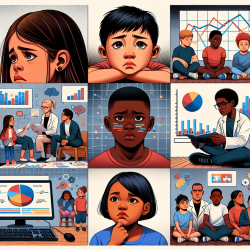Introduction
The COVID-19 pandemic has had a profound impact on children's education and well-being, leading to what the United Nations has termed a "generational catastrophe." The research article "Understanding and attenuating pandemic-related disruptions: a plan to reduce inequalities in child development" provides a comprehensive analysis of these impacts and offers strategies for recovery. This blog will explore how practitioners can leverage these findings to improve outcomes for children, particularly those from disadvantaged backgrounds.
Key Findings and Implications
The research highlights three main areas of concern: learning loss, mental health and well-being, and healthy lifestyle. Each area requires targeted interventions to mitigate the pandemic's effects.
Learning Loss
School closures and the shift to online learning have disproportionately affected children from socio-economically disadvantaged backgrounds. The research suggests that learning losses could increase the performance gap by 30% between children with and without academic challenges. Practitioners should focus on providing targeted tutoring and support, especially in disadvantaged areas, to bridge this gap.
Mental Health and Well-being
Mental health issues among youth have doubled during the pandemic, with one in four experiencing depression symptoms. Practitioners should implement cognitive behavioral approaches and virtual mindfulness interventions to support mental health. Tailored programs for at-risk groups are essential to address these challenges effectively.
Healthy Lifestyle
The pandemic has led to increased sedentary behavior and unhealthy eating habits, particularly in vulnerable groups. Practitioners should promote physical activity and healthy eating through structured programs and community initiatives.
Implementing a Monitoring Strategy
A unified monitoring strategy is crucial for assessing the long-term impacts of the pandemic on child development. Practitioners should advocate for data systems that track indicators of learning and well-being longitudinally. This will enable targeted interventions and help distinguish between transient and persistent effects.
Stepped Intervention Strategy
The research proposes a stepped intervention strategy, ranging from universal health promotion to targeted therapeutic interventions. Practitioners should implement this approach to ensure that resources are allocated efficiently and effectively. By focusing on both environmental and individual risk factors, practitioners can tailor interventions to meet the specific needs of different groups.
Conclusion
The pandemic has highlighted the need for a concerted effort to address inequalities in child development. By implementing data-driven strategies and interventions, practitioners can play a crucial role in mitigating the long-term impacts of the pandemic on children's education and well-being. For more detailed insights, practitioners are encouraged to read the original research paper: Understanding and attenuating pandemic-related disruptions: a plan to reduce inequalities in child development.










